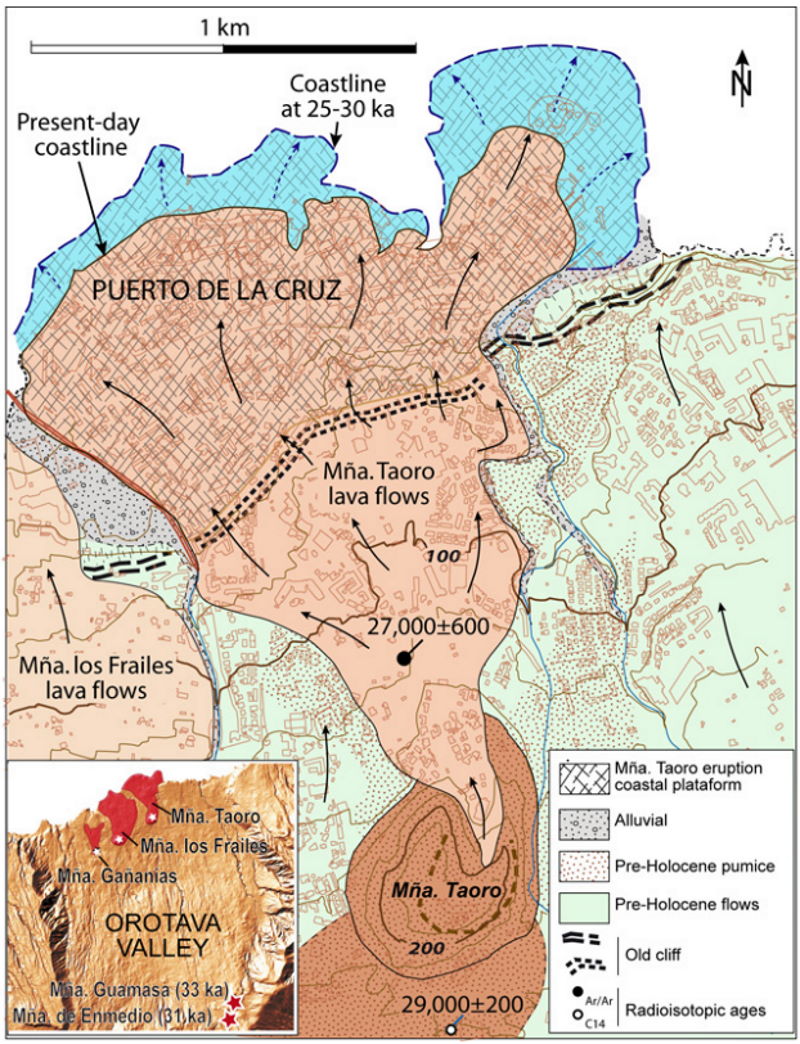The recent volcanic eruption on La Palma got me thinking about the possibilities of an eruption here on Tenerife. I live a mere 300 meters from Monañia Taoro, one of the two very obvious volcanic cones in the Orotava Valley and right in the path of any future eruption lava flow from the crater downhill to Puerto de la Cruz and the sea below. Having read many accounts on various blogs about historic eruptions on Tenerife, I started doing my own research. The information on blogs about these eruptions, it turns out, is often erroneous. One blog I read warned about not trusting what you read and then duplicated unverified accounts of eruptions on the island. It turns out that the Orotava volcanic cones are a classic case of misinterpretation of the age of volcanoes on Tenerife. I've researched the facts presented here from scientific papers and not from other blogs.
There are three cinder cones in the lower La Orotava valley, Montaña Taoro, Montaña Los Failes and Montaña Gananias. The accepted account suggests they erupted together in 1430. Evidence for this had been given verbally in 1776 to Colonel Franqui, who lived in La Orotava, by the indigenous Guanche people. They had told him the formation of these cones occurred about 60 years before the Spanish conquest, that is to say, about 1430. He passed this information on to Jean-Charles de Borda in 1778, who assigned 1430 to their eruption based on this 200-year-old oral account.
Alexander von Humboldt mentions this 1430 eruption of the Orotava Valley cones in his account of his Tenerife visit in 1799, but geological evidence and modern radiocarbon dating of one of the cinder cones (Montaña Taoro, directly south of Puerto de la Cruz) and its lava flows, proves these cones were not active in 1430. The reality is that these volcanic cones are much older and are, in fact, Pre-Holocene and over 29000 years old, forming together in a single multi-vent eruption.

Some features clearly point to a Pre-Holocene eruption of the Taoro volcano. For example, the cone and surrounding lapilli are in an advanced state of erosion. In addition, there is a meter thick deposit on the cone containing quartz residues from thousands of years of dust carried on winds from the Sahara desert. Quartz is absent from rocks on the Canary Islands, so this clearly indicates origins from the African Sahara desert. This geological evidence alone rules out an eruption within the last 600 years.
The Guanche oral account of the 1430 eruption is likely to reference a large forest fire. Calibrated radiocarbon dating of carbon remains found widely distributed in the valley are estimated between 1294 and 1426 AD. An extensive forest fire could have caused these remains shortly before the Spanish conquest of the island, as the dates do not align with any volcanic eruption.
Reports of eruptions on Tenerife are almost always interpreted from written assertions and not from analytical data, often leading to inaccuracies in historical accounts of eruptions. Once misinterpreted, erroneous reports of historical eruptions become accepted and perpetuated in subsequent publications.
These inaccurate accounts of the frequency of volcanic eruptions on Tenerife lead to the overestimation of the volcanic hazard of the island. For example, the estimated frequency for eruptions on Tenerife was approximately every 30 years, but now most of the Holocene eruptions have been radiocarbon dated the frequency of eruptions is 3-7 per thousand years (Carracedo et al., 2007).
And finally, I'm hoping the cone near my house is a monogeneric cinder cone that only erupts once, but I've read that there can be tens of thousands of years between eruptions of ancient cinder cones. Only time will tell.
References and Acknowledgements
Carracedo, J.C., B. Singer, B. Jicha, F.J. Pérez Torrado, H. Guillou, E.R. Badiola, and R. Paris. “Pre-Holocene Age of Humboldt's 1430 Eruption of the Orotava Valley, Tenerife, Canary Islands.” Geology Today 26, no. 3 (0AD): 101–4. doi:10.1111/J.1365-2451.2010.00754.X.





